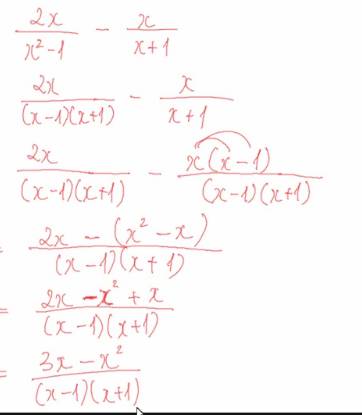
Phương trình bậc nhất một ẩn
c: =>4y^2-4y+1=0
=>(2y-1)^2=0
=>2y-1=0
=>y=1/2
d: =>y^2-2y-80=0
=>(y-10)(y+8)=0
=>y=10 hoặc y=-8
Đúng 0
Bình luận (0)
một hồ bơi hình chữ nhật có chiều dài 3x + 1 và chiều rộng 6 - x Tính diện tích hồ bơi lớn nhất khi x đạt giá trị nào
\(S=\left(3x+1\right)\left(6-x\right)=18-3x^2+6-x=-3x^2+17x+6\)
Đặt \(A=-3x^2+17x+6\)
\(S_{max}\Leftrightarrow A_{max}=-3\left(x^2-\dfrac{17}{3}x-2\right)=-3\left[x^2-2.x.\dfrac{17}{6}+\left(\dfrac{17}{6}\right)^2-\left(-\dfrac{17}{6}\right)^2-2\right]\)
\(=-3\left[\left(x-\dfrac{17}{6}\right)^2-\dfrac{361}{36}\right]\)
\(=-3\left(x-\dfrac{17}{6}\right)^2+\dfrac{361}{12}\)
Vì \(-3\left(x-\dfrac{17}{6}\right)^2\le0\forall x\in R\)
\(\Rightarrow-3\left(x-\dfrac{17}{6}\right)^2+\dfrac{361}{12}\le\dfrac{361}{12}\forall x\in R\)
\(\Rightarrow A_{max}=\dfrac{361}{12}\Leftrightarrow\left(x-\dfrac{17}{6}\right)^2=0\Leftrightarrow x=\dfrac{17}{6}\)
\(\Rightarrow S_{max}\Leftrightarrow x=\dfrac{17}{6}\)
Đúng 1
Bình luận (0)
Mọi người ơi giúp mik với mai mik học rồi mà mik chx làm xong, cho mi câu trả lời chi tiết và rõ ràng nhất với ạ, xong thì mik sẽ tick, mik cảm ơn ( cái ảnh thứ 2 là ảnh cách làm ạ)
Đọc tiếp
Mọi người ơi giúp mik với mai mik học rồi mà mik chx làm xong, cho mi câu trả lời chi tiết và rõ ràng nhất với ạ, xong thì mik sẽ tick, mik cảm ơn ( cái ảnh thứ 2 là ảnh cách làm ạ)


\(\dfrac{1}{x^2-4}+\dfrac{2x}{x+2}=\dfrac{1}{\left(x-2\right)\left(x+2\right)}+\dfrac{2x}{x+2}=\dfrac{1+2x\left(x-2\right)}{\left(x-2\right)\left(x+2\right)}=\dfrac{1+2x^2-4x}{\left(x+2\right)\left(x-2\right)}\)
trên bài mink đã ẩn đi bước quy đồng!!
\(\dfrac{18}{\left(x-3\right)\left(x^2-9\right)}-\dfrac{3}{x^2-6x+9}-\dfrac{x}{x^2-9}=\dfrac{18}{\left(x-3\right)\left(x+3\right)\left(x-3\right)}-\dfrac{3}{\left(x-3\right)^2}-\dfrac{x}{\left(x-3\right)\left(x+3\right)}\)
\(=\dfrac{18}{\left(x-3\right)^2\left(x+3\right)}-\dfrac{3}{\left(x-3\right)^2}-\dfrac{x}{\left(x-3\right)\left(x+3\right)}=\dfrac{18-3\left(x+3\right)-x\left(x-3\right)}{\left(x-3\right)^2\left(x+3\right)}\)
\(=\dfrac{18-3x-9-x^2+3x}{\left(x-3\right)^2\left(x+3\right)}=\dfrac{9-x^2}{\left(x-3\right)^2\left(x+3\right)}=\dfrac{-\left(x-3\right)\left(x+3\right)}{\left(x-3\right)^2\left(x+3\right)}=\dfrac{-1}{x-3}\)
Đúng 2
Bình luận (0)
`F=[x^2-4x+5]/[x^2-4x+6]=1-1/[x^2-4x+6]=1-1/[(x-2)^2+2]`
Vì `(x-2)^2 >= 0 AA x<=>(x-2)^2+2 >= 2 AA x`
`=>1/[(x-2)^2+2] <= 1/2 AA x`
`=>-1/[(x-2)^2+2] >= -1/2 AA x<=>F >= 1/2 AA x`
Dấu "`=`" xảy ra `<=>x-2=0<=>x=2`
______________________________________________
`D=[x^2-4x+10]/[x^2-4x+6]=1+4/[x^2-4x+6]=1+4/[(x-2)^2+2]`
Vì `(x-2)^2 >= 0 AA x<=>(x-2)^2+2 >= 2 AA x`
`<=>4/[(x-2)^2+2] <= 2 AA x<=>D <= 3 AA x`
Dấu "`=`" xảy ra `<=>x-2=0<=>x=2`
Đúng 3
Bình luận (0)
bai dau???????????????????????????
Đúng 0
Bình luận (0)
Giải pt sau:x^2-7=0
=>x2=7
hay \(x=\pm\sqrt{7}\)
Đúng 1
Bình luận (0)
A= (\(\dfrac{x-2}{2x-2}\)+\(\dfrac{3}{2x-2}\)-\(\dfrac{x+3}{2x+2}\)):(1-\(\dfrac{x-3}{x+1}\))
a,Tìm đk của x để giá trị của biểu thức được xác định
b,Tính giá trị của biểu thức khi x=2005
c,tìm giá trị của x để A có giá trị bằng -1002,
a,dfrac{2}{x-2}-dfrac{2}{x^2-x-2}.(1+dfrac{3x+x^2}{x+3})b,dfrac{2}{xy}:(dfrac{1}{x}-dfrac{1}{y})-dfrac{x^2-y^2}{left(x-yright)^2}c,(dfrac{x+y}{2x-2y}-dfrac{x-y}{2x+2y}-dfrac{2y^2}{y^2-x^2}):dfrac{2y}{x-y}
Đọc tiếp
a,\(\dfrac{2}{x-2}\)-\(\dfrac{2}{x^2-x-2}\).(1+\(\dfrac{3x+x^2}{x+3}\))
b,\(\dfrac{2}{xy}\):(\(\dfrac{1}{x}\)-\(\dfrac{1}{y}\))-\(\dfrac{x^2-y^2}{\left(x-y\right)^2}\)
c,(\(\dfrac{x+y}{2x-2y}\)-\(\dfrac{x-y}{2x+2y}\)-\(\dfrac{2y^2}{y^2-x^2}\)):\(\dfrac{2y}{x-y}\)
a: \(=\dfrac{2x+2-2}{\left(x-2\right)\left(x+1\right)}\cdot\left(1+x\right)\)
=2x/x-2
b: \(=\dfrac{2}{xy}:\dfrac{y-x}{xy}-\dfrac{x+y}{x-y}\)
\(=\dfrac{-2}{x-y}-\dfrac{x+y}{x-y}=\dfrac{-2-x-y}{x-y}\)
c: \(=\dfrac{x^2+2xy+y^2-x^2+2xy-y^2+4y^2}{2\left(x+y\right)\left(x-y\right)}\cdot\dfrac{x-y}{2y}\)
\(=\dfrac{4y^2+4xy}{2\left(x+y\right)}\cdot\dfrac{1}{2y}=\dfrac{4y\left(x+y\right)}{4y\left(x+y\right)}=1\)
Đúng 1
Bình luận (1)
Tìm m để phương trình sau: (m-1)x=m^2-1
a) vô nghiệm
b) vô số nghiệm
c) có nghiệm duy nhất
cảm ơn đã giúp mik ![]()
a: Để phương trình vô nghiệm thì \(m\in\varnothing\)
b: Để phươg trình có vô số nghiệm thì m-1=0
hay m=1
c: Để phương trình có nghiệm duy nhất thì m-1<>0
hay m<>1
Đúng 1
Bình luận (0)









